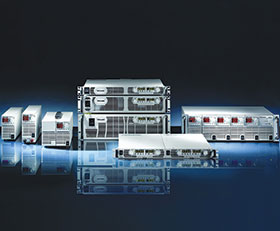

There are many things that impact the life of a power supply, overstressed components being the main one. All components have a life that is affected by temperature; some components are more strongly affected than others. The design life of modern power supplies is therefore limited by those components and the electromechanical parts, such as fans and relays, all of which have different wear-out rates.
In a typical power supply, it is the electrolytic capacitors that dominate the design life. In most cases, there are three different uses for electrolytic capacitors in a power supply – in the start-up circuit, as an input bulk capacitor, and for output smoothing – each having a different impact on power supply performance as it wears out and eventually fails.
Start-up capacitor
Looking at each of these locations, we first focus on the start-up capacitor: on initial power up, this capacitor is charged and the energy stored in it is used to power the control ICs, whilst the power supply output is established. Once the power supply is running, the control circuit is powered by the power supply, so this capacitor then serves no useful function.
As the capacitor wears out, it stores less and less energy until eventually getting to a point where it stores insufficient energy for the power supply to start up – this is a common failure mechanism in server applications where the power supply is running warm all of the time.
As the start-up capacitor dries out, it no longer functions properly, but this isn’t apparent since the power supply is already running. If, however, the power supply is turned off for routine maintenance, it may not turn back on.
Bulk capacitor
For the bulk capacitor (which is the output capacitor of the power factor correction circuit in a typical power supply), the consequence of wear-out is reduced power supply hold-up.
A typical power supply will have around 20 ms of hold-up time when new, but as the bulk capacitor’s electrolyte gradually evaporates over time the capacitance is reduced and hold-up time falls. This generally manifests itself as intolerance to brownouts, causing ‘soft errors’ in electronic equipment.
Good designs will take account of this and select capacitors with a higher value to take account of long-term ageing. Although this increases the cost of the power supply it is usually justifiable in applications requiring hold-up for saving critical data, or to ride through line disturbances or where a long service life is expected by the end equipment user.
Output capacitors
Looking at the output capacitors, wear-out of these typically results in higher levels of ripple and noise, and reduced stability of the control loop. In imaging or test and measurement applications, where very small signals are often measured, a low-noise environment is essential. As the output capacitors age, the ripple and noise increase and the signal-to-noise ratio increases, affecting the performance of the end equipment over time.
In each of these cases, the power supply may not have suffered a hard failure but it has ceased to function correctly, causing host equipment malfunction.
Design margins
Considering the above points, for the start-up capacitor we would choose a device rated for nominal life at 105°C and ensure that it is positioned within the power supply in an area that has a relatively low ambient temperature (as this capacitor is not subjected to significant ripple current and therefore will only need protection from external heating). If the maximum ambient temperature surrounding the capacitor is 75°C, for example, its lifetime would typically be 8 times the 105°C rating.
Similarly for the bulk capacitor, or the PFC capacitor, we would select parts also rated at 105°C. Provided there is a good voltage margin and attention is paid to the thermal design of the power supply, so that the ambient surrounding the capacitor is perhaps 75°C or less, a reasonable operating life is achieved. Cost savings can be found by using 85°C rated capacitors, but then they’ll wear out more quickly. Generally the lower rated capacitors are only used in cost-sensitive consumer applications.
Finally, the output capacitor should also have a low ESR (equivalent series resistance) to cope with the expected high internal ripple currents, and ideally with a pre-filter (ceramic capacitors with a small inductor) for very high ripple current designs. It is on the output capacitor that the impact of ripple current is often overlooked, especially when designing high-density power supplies at a lower cost. Often the pre-filter is compromised for board space and/or cost.
Other components within a power supply, such as devices with bond wires and fuses and even surface-mount devices with end caps, although less affected by elevated temperatures, may have their life reduced by other thermal effects such as thermal expansion and contraction. It is therefore good practice to control the operating temperature of a power supply by limiting the allowed component temperatures at several locations, and not just the electrolytic capacitors. It is especially important for engineers designing-in a power supply to check these temperatures if they are providing the cooling air for the power supply.
To maximise operational life it is vital that end equipment designers pay careful attention to the power supply manufacturer’s installation instructions, in particular ensuring that critical component temperatures are not exceeded. Good power supply vendors will be able to provide technical support and their own design validation measurements to help ensure that the OEM meets its customer’s expectations for field service life.
For more information contact Tobie Muller, Accutronics, +27 11 782 8728, [email protected], www.accutronics.co.za
| Tel: | +27 11 782 8728 |
| Email: | [email protected] |
| www: | www.accutronics.co.za |
| Articles: | More information and articles about Accutronics |

© Technews Publishing (Pty) Ltd | All Rights Reserved